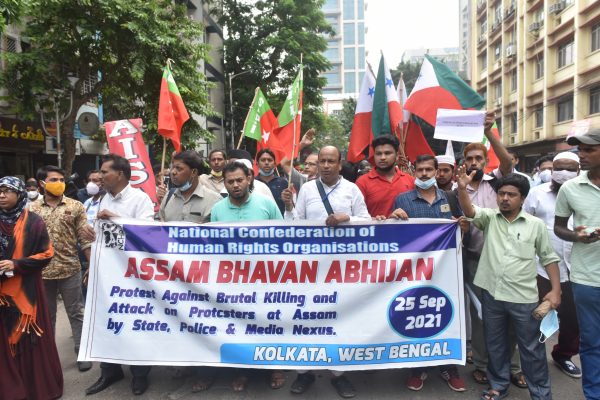Similar dynamics to those which led to the Rohingya refugee crisis are now brewing in India— and both cases reflect systematic state violence, citizenship deprivation and the threat of statelessness against an imagined ‘foreign’ population.
In May 2022, Bangladeshi Foreign Minister AK Abdul Momen said that Rohingya migrants were using brokers to cross into Bangladesh from India. The porous 4000 kilometre border has been a source of contention for decades, but both governments have worked to resolve the issue through exchanging border enclaves and controlling northeastern cross-border militant groups. Still, anti-Bangladeshi rhetoric continues to dominate Indian domestic politics, with the political establishment claiming there are 20 million undocumented Bangladeshi migrants living in India.
According to Momen, some of the Rohingyas who migrated to India to escape persecution in Myanmar are coming to Bangladesh because of the ‘good facilities provided in Cox’s Bazar’, a coastal region in southeastern Bangladesh. Yet India has adopted a draconian policy under which many Rohingyas have been forcefully deported to Myanmar where they face genocide. This fear of deportation is causing Rohingyas in India to seek safety in Bangladesh.
This development is part of a growing hostility in India towards those deemed ‘illegal’ and unworthy of citizenry. The contentious cross-border movement between Bangladesh and India pushed the Indian national imagination towards the proposal of two changes to citizenship laws in 2019. These proposals led to the creation of a national registry of citizenship, known as the National Register of Citizens (NRC) and the Citizenship Amendment Act (CAA) — a law allowing non-Muslim foreigners to become Indian citizens.
The NRC’s roots can be traced to Assam, a state in northeastern India in which the search for racial purity has taken on dangerous forms. Assam’s NRC dates back to the Assam movement of the 1980s when it served as a tool for categorising ‘illegal immigrants’ for deportation. Substantial progress on the registry was made following the win in the state election in Assam in 2016 by the Bharatiya Janata Party (BJP) as part of a larger anti-minority agenda. The BJP introduced the CAA in 2019 to protect people who were deemed more ‘worthy’ and ‘valuable’ to their conception of the Indian nation.
Observers note that the CAA and NRC bear disturbing similarities to Myanmar’s 1982 Citizenship Law which stripped the Rohingya of their citizenship. Myanmar’s then junta government decided that anyone without ancestors from the ‘135 indigenous groups’ of pre-colonial Burma were illegal immigrants. This law shapes Myanmar’s public imagination of Rohingyas as undocumented migrants from Bangladesh—just as the NRC and CAA may shape India’s public imagination towards Bengali Muslims.
During the 2014 national election campaign, then prime ministerial candidate Narendra Modi made the deportation of ‘Bangladeshis’—a term which often refers to Bengali-speaking Muslims in border states—an electoral promise. During the 2019 election campaign, then BJP president and now Home Minister, Amit Shah, described the group as ‘termites’—invoking the same dehumanising language used by Radio Rwanda in the early 1990s. Members of the ruling BJP defended this statement across international media platforms.
State violence toward Bengali-speaking Muslims continues despite the domestic and international advocacy efforts of civil society groups. In September 2021, local Bengali Muslim residents of Assam resisted forced eviction and removal by the police, tragically ending in the brutal police killing of Moinul Haque. Violence against Muslims in border states is now emerging in Tripura — a state with no history of post-partition religious violence.
Bengali Muslims in Mumbai were persecuted under the Shiv Sena administration of Bal Thackeray in the 1990s, but the violence was mostly limited to border states or Indian citizens. In April 2022, many shacks and businesses in Delhi’s Jahangirpuri area belonging to Bengali Muslims (from West Bengal who later settled in Delhi) were reportedly demolished by the North Delhi Municipal Corporation. Over the past year, police raids in Bengaluru have intensified in a bid to track down ‘illegal Bangladeshi migrants’, who are subjected to harassment and even lockups.
Bangladeshi transit visa holders in India have become a target of harassment by a local right-wing television reporter whose broadcast was shared on a Delhi-based politician’s Twitter account. The tweet branded them as undocumented Bangladeshi migrants and Rohingyas.
Increasingly common hate speeches against Muslims by extremist groups at religious events in India threaten the bilateral relations between India and Bangladesh. While Dhaka and New Delhi experience a bonhomie, Bangladesh has witnessed outbursts of anti-Indian government sentiment and grievances have been expressed about Indian government policy by sections of Bangladesh’s intellectual and foreign policy elite in closed-door meetings.
Bangladesh hosts many Indian businessmen, students and professionals. It was the fourth largest remittance source for Indians in 2017 — and the informal figure is estimated to be much higher. But hostility against Bangladeshis in India may jeopardise the safety and livelihood of Indian expats in Bangladesh.
While Dhaka remains silent on these issues, the denaturalisation and vilification of Bengali Muslims in India may encourage the mainstreaming of anti-India sentiment in Bangladesh, adversely affecting bilateral relations.
Rudabeh Shahid is Nonresident Senior Fellow at the Atlantic Council’s South Asia Centre.


Very strategically, no mention of Anti-Hindu violence in Bangladesh, Comilla killings, demolition of Durga Puja pandals. The population of Hindus in Bangladesh has declined from 23% to mere 8% in last 70 years. Meanwhile, the population of Muslims has gone from 15% to 30% in both West Bengal and Assam. So, who is more vulnerable and facing ethnic cleansing? Do Hindus have no right to live? Should India not hold Bangladesh responsible for cleansing of Bengali Hindus?